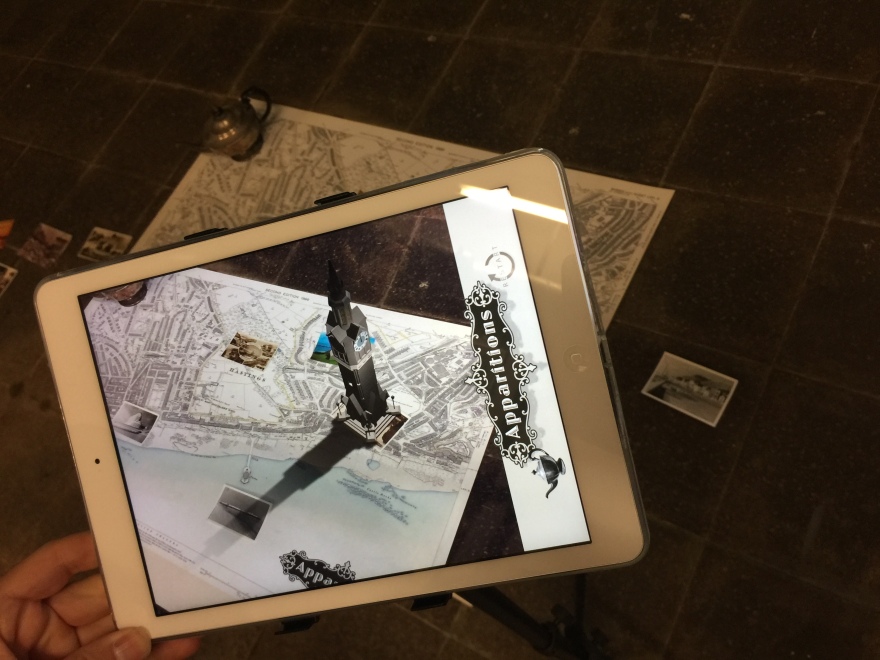Augmented Reality Artwork Reveals Iconic Lost Hastings Landmarks

Internationally recognised digital artist Luciana Haill showcased her new augmented reality artwork at Hastings Museum and Art Gallery on 22nd September 2018 during The Coastal Currents and Brighton Digital Festivals. The “Apparitions” app enables Smartphone users
to interact with animated ghost-like three-dimensional reconstructions of Hastings Memorial, St Leonards Pier and Bexhill beach huts whilst listening to specially created soundscapes. The artworks are triggered by pointing your Smartphone camera at a postcard of the scene in its heyday.
The artist, who moved to Hastings in 2012 launched “Apparitions” in the Durbar Hall at Hastings Museum & Art Gallery on the 22nd September 2018 as part of the Coastal Currents Festival, and Brighton Digital Festival. Since September she has given several talks with demonstrations about the Arts Council England supported project including : The Alley in Claremont ( Trinity Triangle ) , History House / Old Hastings Preservations society and for Bexhill Heritage society.
“Since moving to Hastings and St Leonards I have become fascinated by the history of the area and have collected many personal memories from local inhabitants about these iconic lost landmarks. I am fascinated by the relationship of history, new technologies, memory and dreams. To me these augmented reality landmarks are like ghosts which Smartphones can allow us to see.” (Luciana Haill)
‘Apparitions’ is a new augmented reality art project that reveals the ghosts of historic Edwardian landmarks in Hastings (The Memorial clocktower), St Leonards (The Pier) & Bexhill (beach huts) evoking a nostalgia for lost futures.
Lost heritage sites are recreated in virtual space accompanied by binaural sonic signatures encapsulating their heydays. The experiences are triggered by the Apparitions app when viewing vintage postcards through a smartphone camera & the artwork provokes viewers to capture their own apparition in usual places or by taking a photo when visiting its bygone location.
Augmented Reality (AR) is a live direct or indirect view of a physical, real-world environment whose elements are “augmented” by computer generated sensory inputs such as sound, video, graphics or GPS data and displayed whilst looking at the camera screen of a SmartPhone. The work aims to reveal powerful but forgotten histories of the Hastings and St Leonards area. People are familiar with the recently reconstructed Hastings Pier. However, few know the strange history of the St Leonards Pier, popular for anglers, dancing, roller skating and in its last year of being open to the public strangely hosted a travelling zoo with exotic animals in the late 1930s. It was closed and sectioned during World War Two for defence purposes. It suffered bomb damage in October 1940 and was also damaged by fire. The pier remained closed after the war and suffered severe gale damage on 13th March 1951. Hastings Corporation demolished the remains later that year. All of these occurrences are captured in immersive surreal soundtracks, each travelling through time Hastings Memorial Clocktower was attacked by arsonists in October 1973 and dissembled for scrap by Hastings Borough Council in November.
The most personal apparition is the true story of Bexhill Beach Huts that were destroyed in a storm in 1905. Their contents washing out into the English Channel, never to be seen again. The only surviving possession was a metal plated teapot (featured in the app) which was rescued bobbing about on the shore the next day. A story provided by a Londoner named Alan Clark, whose family holidayed in Bexhill for 2 weeks each & every summer. The teapot has been elevated in the work to symbolised survival and continuity, it appears both virtually in 3D, in the app’s user navigation and for real in the public events.
Editors Notes
* Download the app for iOS (iPhones & iPad) at http://www.apparations.site or via the App Store https://itunes.apple.com/gb/app/apparitions-ar/id1431496591?mt=8
* For interviews and further information, contact: artist@apparitions.site or +44 (0)7973286094
* High-resolution images of the artworks can be downloaded at the following link: https://www.dropbox.com/sh/qz6bb3561k2aztc/AADys3XuIAwWf-WxaQo2B-wYa?dl=0
Images should be credited to Luciana Haill unless otherwise stated in the file name.
* For more information see http://www.apparitions.site
Artists Biography
Luciana Haill is a Fine Artist and Researcher working with digital technologies, neuroscience and dreams. She is artist in residence in the Department of Psychology in Greenwich University London. During the last 25 years she has developed her own brainwave interface and works with medical monitoring equipment to create realtime performances. Combined with scientific strobes and sound to induce altered states of consciousness, reverie and dream like states. Her artist’s cv is available here :https://lucianahaill.wordpress.com/artists-cv/
Her interdisciplinary work has been shown internationally in venues including The Waag in The Netherlands, CENART in Mexico City, with performances for KIBLA in Slovenia, Liverpool International Festival of Psychedelia, Frequency Festival in Lincoln, SPILL in Ipswich, Brighton Digital, The Royal Academy, Kinetica Art Fair and The Science Museum in London. She also performed with artists in The Future of Sound led by musician Martyn Ware in Arts venues across the UK from 2006. Her work was exhibited in the group show ‘Technolgy is Not Neutral’ in Watermans Arts centre Kew and Phoenix Brighton Gallery.
Hastings Museum and Art Gallery
Hastings Museum and Art Gallery Hastings Museum & Art Gallery is a family-friendly museum with a diverse collection. The Museum was established over 120 years ago and offers visitors the opportunity to explore art, culture and history from around the world. The Museum’s has around 97,000 objects of local history, natural sciences, fine & decorative arts, and world cultures. The most spectacular part of the Museum is the magnificent Durbar Hall, constructed for the Colonial & Indian Exhibition in 1886. Donated in 1919 as part of the Brassey Collection, this stunning structure now contains the World Art displays.
http://www.hmag.org.uk/aboutus/about/
Supporters
Judge Sampson Postcards
Arts Council of England
